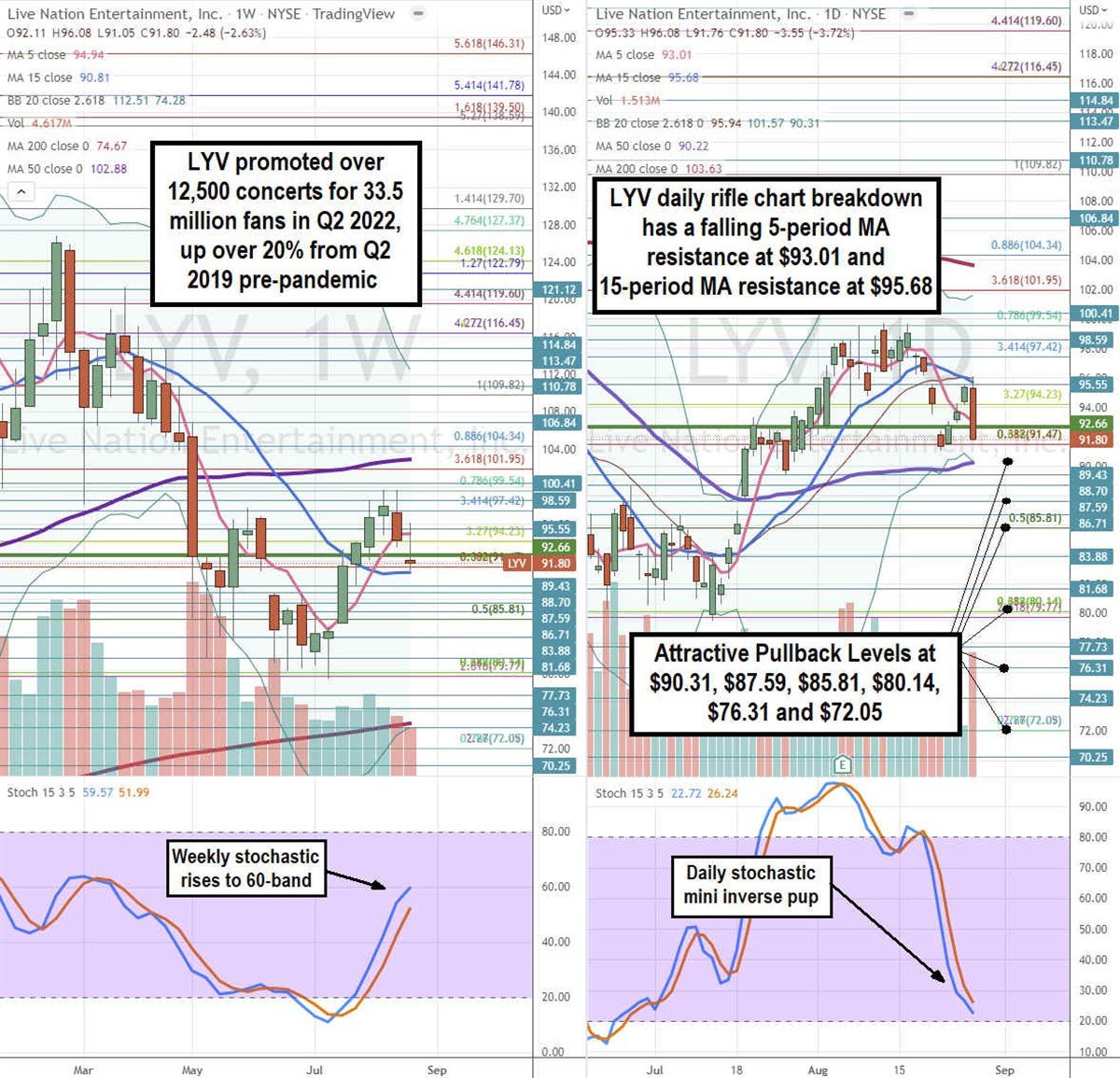Streaming music is driving Live Nation's dominance
The stock of ticketing and live entertainment promotion giant Live Nation (NYSE: LYV) is still down (-24%) for the year despite its best quarter ever. The promotion powerhouse has emerged from the pandemic stronger and more dominant than ever. Live Nation is widely known for operating Ticket Master, but it also owns and operates live event entertainment venues and performs talent management for numerous artists under its Artist Nation brand. The company has been Teflon amid anticompetitive practices, price fixing and lawsuits for hidden charges. Live Nation consolidated the segmented live events market by acquiring promotions and events, very similar to how World Wresting Entertainment (NYSE: WWE) consolidated the professional wrestling industry. The digital streaming trend and e-commerce migration have been tailwinds that have boosted the company's momentum.
 MarketBeat.com - MarketBeat
MarketBeat.com - MarketBeat
Using rifle charts on the weekly and daily time frames provides an accurate view of the landscape for LYV stock. The Rifles weekly chart's downtrend came to a halt as the 5-period moving average (MA) rose to $82.60. The weekly peaked near the $94.32 Fibonacci (fib) level as the weekly stochastic slipped below the 80 band. The weekly stochastic is now crossing the 40 band. ) triggered above $82.26. The weekly upper Bollinger Bands (BB) lie at $89.25. The Rifles chart daily uptrend has a 5-period rising MA at $85.34 with a 15-period rising MA at $83.03. The daily Stochastic is rising through the 80 band. Prudent investors can watch for opportunistic pullback levels at the $84.02, $82.26, $80.46, $79.47, $77.96 and 76 levels. $.27. The upside trajectories range from the $98.55 fib to the $117.46 level.
Back to growthLive Nation is back in the green in a fierce fashion with hit numbers and triple-digit revenue growth. Live Nation promoted more than 12,500 concerts for 33.5 million fans, up 20% from pre-pandemic levels in Q2 2019. Average ticket prices were up 10% from 2019 prices. Revenue was up more than 40% from 2019 levels. Live Nation also added more than 6 million fans in the second quarter, 5 million of which came from international markets, with most global markets reopening for live events. direct. The company said demand for its largest pool of artists is stronger than ever. Big brands like Google (NASDAQ:GOOGL) and Amazon (NASDAQ:AMZN) and Hulu have become new referral customers by connecting with fans (and their spend) around the world. Fan spending increased by more than 20% in June across all sites.
Streaming music model pushes artists to work on live eventsMost music artists earn very little to nothing from actual music sales due to the streaming model. Nobody buys records, cassettes or CDs anymore. Everything is digital. For artists, this means that the only real money comes from live performances at festivals and concert tours. Additional revenue comes from licensing, sponsorships, endorsements, and merchandise sales. Most artists see very little money from music sales. For example, one million streams on

The stock of ticketing and live entertainment promotion giant Live Nation (NYSE: LYV) is still down (-24%) for the year despite its best quarter ever. The promotion powerhouse has emerged from the pandemic stronger and more dominant than ever. Live Nation is widely known for operating Ticket Master, but it also owns and operates live event entertainment venues and performs talent management for numerous artists under its Artist Nation brand. The company has been Teflon amid anticompetitive practices, price fixing and lawsuits for hidden charges. Live Nation consolidated the segmented live events market by acquiring promotions and events, very similar to how World Wresting Entertainment (NYSE: WWE) consolidated the professional wrestling industry. The digital streaming trend and e-commerce migration have been tailwinds that have boosted the company's momentum.
 MarketBeat.com - MarketBeat
MarketBeat.com - MarketBeat
Using rifle charts on the weekly and daily time frames provides an accurate view of the landscape for LYV stock. The Rifles weekly chart's downtrend came to a halt as the 5-period moving average (MA) rose to $82.60. The weekly peaked near the $94.32 Fibonacci (fib) level as the weekly stochastic slipped below the 80 band. The weekly stochastic is now crossing the 40 band. ) triggered above $82.26. The weekly upper Bollinger Bands (BB) lie at $89.25. The Rifles chart daily uptrend has a 5-period rising MA at $85.34 with a 15-period rising MA at $83.03. The daily Stochastic is rising through the 80 band. Prudent investors can watch for opportunistic pullback levels at the $84.02, $82.26, $80.46, $79.47, $77.96 and 76 levels. $.27. The upside trajectories range from the $98.55 fib to the $117.46 level.
Back to growthLive Nation is back in the green in a fierce fashion with hit numbers and triple-digit revenue growth. Live Nation promoted more than 12,500 concerts for 33.5 million fans, up 20% from pre-pandemic levels in Q2 2019. Average ticket prices were up 10% from 2019 prices. Revenue was up more than 40% from 2019 levels. Live Nation also added more than 6 million fans in the second quarter, 5 million of which came from international markets, with most global markets reopening for live events. direct. The company said demand for its largest pool of artists is stronger than ever. Big brands like Google (NASDAQ:GOOGL) and Amazon (NASDAQ:AMZN) and Hulu have become new referral customers by connecting with fans (and their spend) around the world. Fan spending increased by more than 20% in June across all sites.
Streaming music model pushes artists to work on live eventsMost music artists earn very little to nothing from actual music sales due to the streaming model. Nobody buys records, cassettes or CDs anymore. Everything is digital. For artists, this means that the only real money comes from live performances at festivals and concert tours. Additional revenue comes from licensing, sponsorships, endorsements, and merchandise sales. Most artists see very little money from music sales. For example, one million streams on
What's Your Reaction?















![Three of ID's top PR executives quit ad firm Powerhouse [EXCLUSIVE]](https://variety.com/wp-content/uploads/2023/02/ID-PR-Logo.jpg?#)







